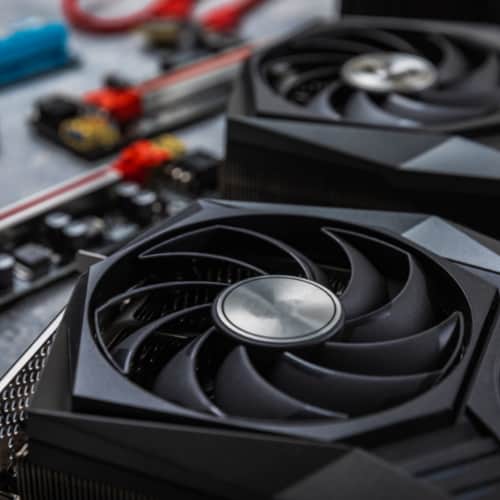A high-performance GPU can make all the difference in delivering a smooth, realistic, and immersive virtual golfing experience. With so many options available on the market, choosing the best graphics card for your golf simulator can be a daunting task.
In this article, we will explore the top GPUs that offer the perfect blend of power, efficiency and compatibility to maximize your golf simulation realism, immersion and enjoyment. We’ll also provide a comprehensive buyer’s guide, highlighting the key factors to consider when selecting a graphics card for your specific needs and budget.
| Product | Features | Our Rating | Purchasing Options |
|---|---|---|---|
 Nvidia Geforce RTX 4090 - The Absolute Best |
| ||
 Nvidia RTX 4080 Super - The Next Best Thing From the Green Team |
| ||
 AMD RX 7900XTX - Very High Performance Relatively More Affordable |
|
Note: Prices listed on this page are subject to change. To view the latest pricing information, please check the vendor's website directly using the links provided.
A Note on Our Suggested Graphics Cards For Golf Simulator
Please note that most golf simulators can work perfectly fine on older graphics cards, such as Nvidia’s 10 series and AMD’s RX 5000 series. If you don’t have a problem setting your software graphics to a lower resolution and graphics quality, anything from the Nvidia GTX 1080TI and AMD’s RX 5700XT will work just fine.
However, if you want to run all settings maxed out at 2K or 4K resolutions, then investing in a more powerful GPU will provide the necessary processing power to keep the simulation smooth and stutter-free. In this case, we recommend investing as much as you can in the highest-end GPU you can afford, which will also future-proof your setup, and you won’t have any problems playing next-gen sim software in higher settings.
That’s why we decided to include graphics cards from the two latest generations from both team Green (Nvidia) and team Red (AMD) – as of the time of writing these lines. Our selection of cards belongs to a wide range of budgets, and will provide peace of mind for a few years to come.
For a more detailed breakdown of the system requirements to run a golf simulator, please refer to our article on the system requirements needed to run a golf simulator.
Remember, again, that even older cards from both companies are still more than capable of running the sim software smoothly, so if you’re on a really tight budget, you can opt for an older card to process your simulation until you can afford an upgrade.
What About Intel GPUs?
Intel got into the GPU market lately with its Arc graphics cards, first introduced in March, 2022. At launch, Intel’s GPUs all faced compatibility and performance issues, which made them very unreliable for gaming and simulation.
The good news is that, two years after the initial launch, compatibility and performance on Intel Arc GPUs have improved greatly, and they can be used for gaming and simulation without any major issues.
However, we still believe that the Arc GPUs need more improvement to become more reliable before we can recommend them for golf simulation. That’s why we limited our choices to Nvidia and AMD cards, but we promise that we will keep an eye on Intel’s improvements on the Arc architecture, and we will include them as soon as we think they are reliable enough for running long simulation sessions.
Our Favorite Graphics Cards to Use with Your Golf Sim Computer in 2025
Based on personal testing and experience, the following are our recommended graphics cards to get for your golf sim computer. We included options from a wide price range to ensure everyone can find something they can afford.
#1 - Nvidia Geforce RTX 4090 – The Absolute Best
The ASUS GeForce RTX 4090 STRIX OC is a top-of-the-line graphics card that delivers unparalleled performance for golf simulator enthusiasts (and any graphics-intensive work you throw at it).
With its cutting-edge NVIDIA Ada Lovelace architecture, this powerhouse GPU offers up to 2x the performance and power efficiency compared to its predecessors, ensuring smooth, lifelike gameplay.
Boasting an impressive 24GB of GDDR6X memory and a blistering 2.61 GHz clock speed, the RTX 4090 is well-equipped to handle even the most demanding golf simulator software at the highest settings and resolutions. The advanced 4th Generation Tensor Cores and 3rd Generation RT Cores provide a significant boost in AI performance and ray tracing capabilities, enhancing the realism and immersion of your virtual golf experience.
ASUS has gone the extra mile with its cooling solution, featuring scaled-up Axial-tech fans that provide 23% more airflow and a patented vapor chamber with a milled heat spreader for optimal GPU temperature management.
The 3.5-slot design, coupled with the diecast shroud, frame, and backplate, maximizes heat dissipation and rigidity, ensuring stable performance during extended gaming sessions.
Additionally, the digital power control system, complete with high-current power stages and 15K capacitors, fuels maximum performance, while the intuitive GPU Tweak III software allows for easy performance tweaking, thermal control and system monitoring.
Pros
- Unmatched performance for golf simulator enthusiasts
- Advanced cooling solution for optimal temperature management
- Intuitive software for performance tweaking and monitoring
- Supports both DisplayPort and HDMI video outputs
- Enhanced realism and immersion with AI and ray tracing
Cons
- Premium price point, most probably prohibitive for most users
- Requires a high-end system to fully utilize its potential
The ASUS GeForce RTX 4090 STRIX OC is an exceptional choice for golf simulator enthusiasts who demand the best performance and visual fidelity. While its premium price tag may be a barrier for some, the uncompromising quality and cutting-edge features make it a worthwhile investment for those seeking the ultimate golf simulator experience.
#2 - Nvidia RTX 4080 Super – The Next Best Thing From the Green Team
The MSI NVIDIA GeForce RTX 4080 Super is another powerful graphics card that can take your golf simulator experience to new heights. With its cutting-edge Ada Lovelace architecture and 16GB of ultra-fast GDDR6X memory, this GPU is well-equipped to handle the demands of modern golf simulator software.
Boasting a boost clock speed of 2625 MHz, the RTX 4080 Super delivers smooth, responsive gameplay, ensuring that your virtual golf rounds feel as close to the real thing as possible. The 256-bit memory interface and 23 Gbps memory speed provide ample bandwidth for high-resolution textures and detailed course renderings.
The RTX 4080 Super’s accelerated ray tracing and AI-powered graphics capabilities bring an unprecedented level of realism to your golf simulator (and other games that support it). From the way light interacts with the course to the subtle details in the grass and trees, every element of your virtual golf environment will look and feel more authentic than ever before.
Pros
- Powerful performance for smooth, responsive gameplay
- 16GB of ultra-fast GDDR6X memory for detailed visuals
- Supports both DisplayPort and HDMI video outputs
- Accelerated ray tracing and AI-powered graphics for enhanced realism
- Ada Lovelace architecture for improved efficiency and performance
Cons
- Higher price point compared to some other graphics cards
- May require a high-wattage power supply for optimal performance
MSI’s NVIDIA GeForce RTX 4080 Super is an excellent choice for golf simulator enthusiasts who want to experience the game in its most realistic and immersive form. While it may come with a higher price tag, the unparalleled performance the card provides outweighs any budget concerns for those looking for a very powerful GPU.
#3 - AMD RX 7900XTX – Very High Performance Relatively More Affordable
The XFX Radeon RX 7900 XTX Speedster Merc 310 is AMD’s flagship graphics card that delivers exceptional performance for much less than the competition’s high-end offerings. Built on AMD’s cutting-edge RDNA3 architecture, this card offers a significant generational leap in performance-per-watt, making it an attractive choice for those seeking the best visual experience in their golf simulator setup.
One of the standout features of the RX 7900 XTX is its impressive 24GB of GDDR6 memory, ensuring smooth and seamless graphics even in the most demanding golf simulator software or other graphics tasks. The card’s 384-bit memory interface and 960 GB/s memory bandwidth provide ample headroom for high-resolution textures and complex course layouts.
XFX has designed the Speedster Merc 310 with a focus on cooling performance, incorporating a large vapor-chamber plate, eight heat pipes, and a trio of 100mm fans. This robust cooling solution allows the card to maintain optimal clock speeds during extended gaming sessions, ensuring a consistent and immersive golf simulator experience.
The RX 7900 XTX also features an upgraded compute unit architecture, with support for new math formats, an AI accelerator, and a 2nd generation Ray Accelerator. These enhancements contribute to the card’s impressive 17.5% IPC uplift and 53% generational performance-per-watt improvement, making it a compelling choice for golf simulator enthusiasts looking to maximize their system’s performance.
Pros
- Exceptional performance for relatively less money
- Ample 24GB GDDR6 memory for high-resolution textures
- Powerful cooling solution for consistent performance
- Significant generational improvements in performance-per-watt
- Gamer-friendly features like reinforcement brace and dual-BIOS
Cons
- Great value for the money, but still not cheap
The XFX Radeon RX 7900 XTX Speedster Merc 310 is an excellent choice for golf simulator enthusiasts who demand the best performance, visual fidelity and bang for the buck. While it comes at a high price point, the card’s impressive specifications, advanced architecture, and thoughtful design make it an excellent investment for those seeking an uncompromised and future-proof golf simulator experience.
#4 - AMD RX 7800XT – Great Balance of Price & Performance
Our next pick – the PowerColor Radeon RX 7800 XT Hellhound is a powerhouse graphics card that delivers exceptional performance for golf simulator enthusiasts. Built on AMD’s cutting-edge RDNA3 architecture, this card is designed to provide an immersive, lag-free experience for any tasks (including golf simulation software).
At the heart of the RX 7800 XT lies the Navi 32 GPU, featuring a chiplet design that combines a 5 nm graphics compute die (GCD) with four memory cache dies (MCDs). This innovative architecture allows for enhanced performance and efficiency, ensuring smooth gameplay even in demanding graphical environments.
With 3,840 stream processors, 120 AI accelerators, and 60 Ray accelerators, the RX 7800XT offers ample power to handle complex course renderings and realistic ball flight physics. The 16 GB of GDDR6 memory, coupled with a 256-bit memory interface, provides an impressive 624 GB/s of bandwidth, allowing for seamless loading of high-resolution textures and detailed course maps.
The PowerColor Hellhound version of the RX 7800 XT comes factory overclocked to 2213 MHz Game clock, surpassing the reference 2124 MHz. This extra boost in performance ensures that your golf simulator runs smoothly, even during intense moments of play. The card also features a triple-slot cooling solution, complete with easy-to-maintain fans, double ball bearings, and LED illumination for both style and functionality.
Pros
- Excllent performance
- Innovative RDNA3 architecture with chiplet design
- Factory overclocked for enhanced performance
- Robust cooling solution with easy-to-maintain fans
- 16 GB GDDR6 memory
Cons:
- Triple-slot design may require a spacious PC case
PowerColor’s Radeon RX 7800 XT Hellhound is an excellent choice for golf simulator enthusiasts seeking a high-performance graphics card. With its powerful RDNA3 architecture, factory overclock and efficient cooling, this card delivers a smooth, immersive virtual experience. While its triple-slot design and power consumption may be considerations for some, the RX 7800 XT’s performance more than justifies its place in any serious golf simulator setup.
#5 - Nvidia RTX 3090TI – The Former Champion
The Nvidia GeForce RTX 3090 Ti is an incredibly powerful graphics card that will satisfy even the most demanding golf simulator enthusiasts. With a whopping 10,752 CUDA cores and 24GB of blazing-fast GDDR6X VRAM, this GPU delivers excellent performance for rendering stunningly realistic golf courses and ball flight in 4K and even 8K resolution.
For virtual golf setups, the RTX 3090 Ti’s raw power means you’ll experience smooth frame rates and fast load times, even when the most graphically intense courses are processed. Nvidia’s 2nd generation raytracing cores add to the immersion, realistically simulating shadows, reflections and lighting for an amazingly lifelike experience that rivals out on an actual golf course.
The 3090 Ti’s beefy heatsink and triple-fan design keep temperatures in check during long simulator sessions. At 450W TDP, the card does draw a lot of power, so make sure your rig has an adequate 850W+ power supply. It’s also a physically large card, so check that you have sufficient case clearance.
For most users, the RTX 3090 or 3080 Ti will be more than sufficient, but if you demand the very best, the 3090 Ti is in a class of its own.
Pros
- Incredible performance for demanding 4K/8K golf simulator visuals
- 24GB VRAM handles the most detailed courses with ease
- Ray tracing elevates realism to new heights
- Runs cool and quiet thanks to beefy heatsink design
- Future-proof specs to handle next-gen simulator software
Cons
- Sky high price compared to other capable cards
- Requires a high-wattage power supply and lots of case space
- Overkill specs for many golf simulator users
The Nvidia GeForce RTX 3090 Ti is a great graphics card for the ultimate golf simulator setup. If you’re a hardcore simulator enthusiast seeking to build an uncompromising rig for experiencing golf in the highest fidelity, the 3090 Ti will deliver that experience without a sweat. Just be prepared to pay a premium and have a monster PC to handle this monster of a GPU.
#6 - AMD RX 6950XT – AMD’s Former Flagship GPU
Next on our list is the Sapphire Radeon RX 6950 XT Pure, a powerful graphics card that’s sure to elevate your golf simulator experience. Built on the RDNA2 architecture and Navi 21 silicon, this card boasts an impressive 5,120 stream processors, 80 Ray Accelerators, and 16 GB of GDDR6 memory. What does this mean for you? Stunning visuals, gameplay and an immersive virtual environment.
The RX 6950 XT boasts an increased engine clock speed. At 2100 MHz, it outpaces its predecessor, the RX 6900, putting it in the league of some of the fastest factory-overclocked cards on the market. This translates to better performance and faster rendering times, ensuring your golf simulator runs seamlessly.
AMD has also equipped the RX 6950 XT with faster 18 Gbps GDDR6 memory, providing a significant 12.5% increase in memory bandwidth compared to the RX 6900 XT. This enhancement, coupled with the 128 MB Infinity Cache, ensures that your golf simulator has the necessary memory resources to handle even the most demanding courses and environments.
While the increased power consumption of 335 W might raise some concerns, AMD assures that the reference cooler can handle the extra heat. Sapphire’s latest-generation Ice Storm air cooler, a beefy three-slot design with intricate heatsinks, should provide ample cooling for the RX 6950 XT Pure.
Pros
- Very powerful GPU from AMD’s former generation
- Faster clock speeds and memory bandwidth
- Infinity Cache for enhanced memory efficiency
- Premium build quality and cooling solution
- Future-proof investment
Cons
- Nothing we could think of
The Sapphire Radeon RX 6950 XT Pure is still a very powerful and efficient graphics card that offers great performance. It is an excellent choice for enthusiasts who demand the best visuals and gameplay.
#7 - Nvidia RTX 4070 Super – Great Mid-Range GPU for 2K Simulation
This graphics card comes equipped with the horsepower to render the most visually demanding courses with ease, ensuring that every blade of grass and subtle slope is presented in stunning detail. The realism it brings to golf simulators is not just about the visuals; it’s about feeling immersed in the game as if you’re standing on the course itself.
The card’s performance doesn’t end with graphics. Its advanced AI-driven technologies, like DLSS, allow for smoother frame rates without compromising on image quality. This means you can enjoy a fluid swing motion and immediate feedback on your shots, critical aspects of any golf simulator.
However, for those with older PC setups, the RTX 4070 SUPER might necessitate a few upgrades elsewhere in your system to fully use its capabilities. You might need a new PSU or case to accommodate this GPU.
Pros
- Renders courses with exceptional detail
- Immersive experience with realistic lighting
- Advanced ray tracing capabilities
- Smooth frame rates with AI-driven technologies
- Very efficient compared to Nvidia’s higher-end models
Cons
- May require additional PC upgrades
So, what’s the final verdict? The GeForce RTX 4070 SUPER is a powerful ally for any golfer looking to enhance their simulator experience. If you’re serious about your virtual golf practice sessions and willing to invest in the best, this graphics card is hard to beat.
#8 - AMD RX 6800XT – Another Great Mid-Range Card
The ASUS TUF GAMING Radeon RX 6800 XT OC 16G is a high-end GPU from the former generation of Radeon cards. Built on the AMD RDNA2 architecture, this card boasts 72 compute units, 288 texture units, 64 ROPs, and 72 ray accelerator units, ensuring smooth, high-quality visuals.
This card’s cooling system is overkill. The industrial-style aluminum shroud and three 10cm fans work together to keep temperatures under control, even during intensive sessions. The dual BIOS mode allows you to prioritize either performance or quiet operation, depending on your preferences.
When it comes to connectivity, the RX 6800 XT has you covered with one HDMI 2.1 and three DisplayPort 1.4a ports. The card’s impressive 16GB of GDDR6 memory is particularly advantageous for 4K gaming and VR applications, providing ample headroom for demanding scenarios.
In our benchmarks, the RX 6800 XT consistently outperformed competitors like the RTX 3060 Ti and RTX 2080, cementing its position as a high-end graphics card. The card’s ability to boost up to 2490 MHz further contributes to its exceptional performance.
Pros
- Exceptional performance for golf simulators
- Robust cooling system and dual BIOS
- 16GB GDDR6 memory for 4K and VR
- Versatile connectivity options
- Supports hardware-accelerated ray tracing
Cons
- Higher power consumption compared to some competitors
In conclusion, the ASUS TUF GAMING Radeon RX 6800 XT OC 16G is an excellent choice for golf enthusiasts seeking a high-performance graphics card for their simulator setup. With its powerful AMD RDNA2 architecture, effective cooling, and generous memory, this card delivers the visual fidelity and smooth gameplay that golf simulators demand. While its price and power consumption may be considerations for some, the RX 6800 XT’s overall performance and features make it a strong contender in its class.
#9 - AMD RX 7700XT – Excellent Budget GPU for 1080P
The ASRock Challenger Radeon RX 7700 XT offers compelling performance for golf simulation enthusiasts seeking high-quality visuals at 1080p and 1440p resolutions. While not the absolute fastest option available, this graphics card delivers reliable frame rates in a compact, well-designed package.
Under the hood, the RX 7700 XT packs 12GB of GDDR6 memory on a 192-bit bus, providing ample capacity and bandwidth for smooth gameplay. The GPU core, based on AMD’s refined Navi 32 architecture, integrates 54 compute units and ray accelerators. Thoughtful design elements like the metal backplate and effective dual-fan cooler reflect ASRock’s attention to build quality.
In practical gaming scenarios, the RX 7700 XT capably handled our suite of golf simulators at 1080p and 1440p. Titles like The Golf Club 2019 and Jack Nicklaus Perfect Golf ran fluidly, with crisp ball flight and course details. More demanding software pushes the limits at 4K, but that’s not unexpected for a card in this class.
ASRock’s card does impress in the noise and heat departments. Even during intense benchmark sessions, the fans maintained whisper-quiet operation while keeping temperatures in check. That cool-and-collected demeanor makes it an unobtrusive addition to simulator builds.
Pros
- Delivers fluid 1080p/1440p golf simulator performance
- 12GB VRAM for demanding courses and effects
- Effective cooler keeps noise and temperatures low
- Compact design fits neatly in most cases
- Quality metal backplate and power components
Cons
- Lags noticeably behind in ray-tracing tasks
- Priced close to faster RX 7800 XT models
For golf enthusiasts prioritizing smooth 1080p and 1440p simulator performance in a well-built, compact card, the ASRock Challenger RX 7700 XT warrants consideration. The 12GB VRAM buffer and refined Navi 32 architecture handle most golfing software demands. However, the price-to-performance ratio diminishes when weighing the ray-tracing deficit and narrow cost delta to swifter RX 7800 XT alternatives.
#10 - Nvidia RTX 4060 TI – Also Great for 1080P Simulation
The Zotac RTX 4060 Ti 16GB AMP is a solid choice for golf simulator enthusiasts seeking a balance between performance and value. With its doubled VRAM capacity compared to the 8GB model, this card offers some advantages in specific workloads while maintaining the same core specs as its sibling.
One key benefit of the extra memory is in AI applications, which many modern golf simulators rely on for ball tracking and shot analysis. The 16GB of VRAM can better handle larger AI models, potentially leading to smoother performance and faster processing times. However, it’s important to note that the 128-bit memory bus may still limit the GPU’s full potential in some cases.
For golf simulator visuals, the RTX 4060 Ti 16GB delivers decent 1080p gaming performance, thanks to its Ada Lovelace architecture and advanced features like DLSS 3. You can expect crisp graphics and fluid animations, enhancing the immersion of your virtual rounds.
While the extra VRAM costs more, it’s still an affordable option compared to higher-end cards like the RTX 4070 or AMD’s RX 6800 series. For golf simulator setups that don’t require extreme resolutions or frame rates, the 4060 Ti 16GB offers a balanced package that won’t break the bank.
Pros
- Doubled VRAM beneficial for AI workloads
- Solid 1080p gaming performance for simulators
- DLSS 3 and ray tracing enhance visuals
- More affordable than higher-end alternatives
- Factory overclocked for higher performance boost
Cons:
- 128-bit memory bus may bottleneck performance
- $100 premium over 8GB model feels steep
- Not ideal for 1440p or 4K golf simulations
In conclusion, the Zotac RTX 4060 Ti 16GB AMP is a capable choice for golfers prioritizing smooth performance and immersive visuals at 1080p. While the extra VRAM comes at a cost, it can provide benefits in AI-heavy applications. Just be aware of the potential limitations posed by the 128-bit memory bus. If your simulator setup demands higher resolutions or extreme frame rates, you may want to consider stepping up to a more powerful card.
Buying Guide – Factors to Consider in Your Graphics Card for Golf Simulator
When selecting a graphics card for your golf simulator PC, there are several key factors to consider to ensure optimal performance, compatibility and value for money. Whether you’re using your PC solely for golf simulation or plan to use it for gaming as well, these factors will help you make an informed decision.

Performance
Performance is a crucial aspect to consider when choosing a graphics card for your golf simulator PC. Look for a GPU with high clock speeds and a large number of CUDA cores (Nvidia) or Stream Processors (AMD) to ensure smooth and responsive gameplay.
The GPU’s architecture and technology, such as Nvidia’s Turing or Ampere, or AMD’s RDNA, also play a significant role in performance and efficiency, with newer architectures often offering better results.
To gauge a GPU’s performance in golf simulator software and popular games, check benchmark scores and reviews from reliable sources.
Dedicated Memory (VRAM)
Dedicated memory, or VRAM, is another essential factor to consider. For golf simulators, which often feature high-resolution textures and detailed course renderings, it’s recommended to opt for a GPU with at least 8 GB of VRAM.
If you plan to use your PC for more demanding games or want to future-proof your setup, consider GPUs with 16 GB or more VRAM.
Additionally, look for fast memory types like GDDR6 or HBM2, which offer improved performance and bandwidth compared to older memory technologies.
Nvidia vs. AMD
When it comes to choosing between Nvidia and AMD graphics cards, both brands offer excellent options suitable for golf simulators and gaming.
Nvidia’s GeForce RTX series is known for its superior ray tracing and AI-enhanced features, which can enhance realism and visual quality in supported games.
On the other hand, AMD’s Radeon RX series provides competitive performance and often better value for money, especially in the mid-range segment.
Consider the specific features and technologies offered by each brand, such as Nvidia’s DLSS or AMD’s FidelityFX Super Resolution, which can boost performance and image quality in compatible titles.
Power Consumption
Power consumption is another crucial factor to keep in mind when selecting a graphics card. High-performance GPUs often consume more energy and generate more heat, so it’s essential to ensure that your PC’s power supply unit (PSU) can handle the GPU’s power demands.
If necessary, consider upgrading your PSU to accommodate the new graphics card. Additionally, look for GPUs with efficient cooling solutions, such as larger heatsinks, multiple fans or liquid cooling, to keep temperatures in check and maintain stable performance during extended gaming or simulation sessions.
With that said, if power consumption is very important to you, then you should know that AMD’s options are more power-efficient than Nvidia’s high-end GPUs. Nvidia’s 4060 and 4070 GPUs are also relatively more efficient compared to the power-hungry RTX4090 or RTX4080.
Max Settings at 4K vs. Lower Settings at 1080P
If you prioritize visual quality and have a 4K projector, you may want to opt for a high-end GPU that can handle maximum settings at this resolution (with the RTX 4090, 4080, and RX7900XTX and RX7900XT being the best options). Keep in mind that running golf simulators and games at 4K with max settings is highly demanding and will require a top-tier graphics card.
On the other hand, if you prefer smoother gameplay and faster frame rates, you may want to consider running your golf simulator at 1080P with lower settings. This approach will allow you to achieve higher frame rates and a more responsive experience, even with mid-range GPUs like the Nvidia GeForce RTX 3060 Ti or AMD Radeon RX 6700 XT.
Ultimately, the choice between 4K max settings and 1080P lower settings depends on your personal preferences, budget and the specific requirements of your golf simulator software.
Value for Money

Finally, value for money is a key consideration when choosing a graphics card for your golf simulator PC.
Evaluate your budget and compare the price-to-performance ratio of different GPUs within your price range to find the best value for your needs.
Keep in mind that the most expensive GPU may not always be necessary for a smooth golf simulator experience, and mid-range options can often provide excellent performance at a more affordable price point.
It’s worth mentioning that when it comes to value for the money, AMD is the winner, compared to Nvidia, which offers some more powerful GPUs, but the value is simply not there.
Final Thoughts
Choosing the best graphics card for your golf simulator is a critical decision that can significantly impact your overall experience. By considering factors such as performance, compatibility, memory, cooling, and budget, you can narrow down your options and find the perfect GPU to suit your needs.
Investing in a quality graphics card will ensure that your golf simulator runs smoothly, delivers stunning visuals, and provides an immersive and enjoyable experience. Also, the options reviewed here all offer decent future-proofing, as they will all serve you for years to come. You will be well prepared when the next-gen golf simulation arrives.
Even the most powerful graphics card won’t perform optimally without a high-performance computer for golf simulation software. Choosing the right PC with a powerful processor, ample RAM, and sufficient storage is crucial for smooth gameplay and realistic graphics.
To further enhance your knowledge on creating the ideal golf simulation setup at home, it’s important to understand the role your computer plays in the process. Not only does the GPU matter, but the overall computer performance as well—from its processor to RAM and storage, all components need to work in harmony for the best experience.
For those who want to deep dive into ensuring their system is up to par, you can check out our ultimate guide to computers for home golf simulators.
If you still have questions or comments, please contact us.












